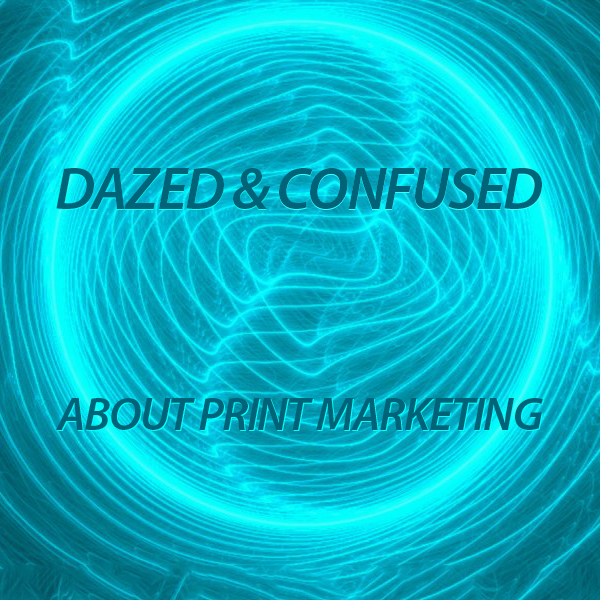Welcome back inkheads—hope you enjoyed the loooong weekend over the 4th of July holiday!
A week ago today, yours truly participated in a Social Media Day 2014 Facebook Q & A on the Social Solutions Collective page. We didn’t have a huge turnout.
Nevertheless, one small biz owner posed a question that always seems to come up in print marketing discussions: Do *insert various printed products here i.e. flyers, postcards, rack cards, etc.)* still work?
The specific circumstances don’t matter because we’ve all heard this one before. A small biz owner or marketing professional hears horror stories about expensive campaigns that failed miserably. You know the drill. A friend mailed 15,000 beautifully designed postcards and got no responses. Since there were no issues with the artwork or printing quality, these folks blame the entire medium instead of digging deeper to find the true culprit.
Surface scratching of this nature would be yet another example of mental shortcuts aka heuristics and anti-print prejudice. Beyond that, it’s nearly impossible to determine whether or not a printed component would benefit an integrated campaign without defining the goals first. So the next time someone asks you if print ‘works,’ ask this person to explain what they’re trying to accomplish!
Then you can attempt to explain what might’ve gone wrong in a tale of anecdotal evidence…
6 Reasons Why Your Friend’s Print Marketing Campaign Failed
Marketers mainly aim to increase sales, which is what most of them are really asking about with these vague, ‘does print work’ questions. They want to hone in on ROI, especially since online marketing solutions are promoted as free advertising options. We all know nothing’s free in this world, but remember, we’re dealing with surface scratchers here.
Print requires some sort of budget, which means you can’t afford to waste money on lackluster communications. The following list contains 6 common characteristics of failed direct mail promotions:
#1) Poor List Quality- Direct mail success depends heavily on your mailing list. For instance, did you collect the list yourself using your customer database or purchase addresses from a third party? Here at PrintFirm, we provide lists for clients who don’t have databases, and we work with trusted sources to obtain this info for you. That said, beware of bad lists! Shady lists may consist of deceased consumers and other such nonsense. If at all possible, perform a manual inspection before you make a purchase!
#2) Ignored Loyal Customers- You use direct mail to generate new business, right? Well, yes and no. New business doesn’t necessarily mean that you attract brand new clients from postcards, even with EDDM (Every Door Direct Mail). Choose a neighborhood where you know several of your current customers live for better returns on your next EDDM blast. Why? Research shows that sending those postcards to your current customers instead of fresh prospects yields higher response rates. This makes sense when you consider your own behavior. You probably feel comfortable dealing with familiar brands because they’ve earned your trust. Your clients likely feel the same way!
#3) No Call to Action- This one’s a doozy as it appears to elude many a small biz owner. Let’s say you print flyers announcing a summer sale, and you pass them out to shoppers inside your store. Your design’s got celebratory confetti, pro product photos with super low prices written in a bold typeface. Yet your copy doesn’t speak directly to the reader—you don’t invite the flyer recipients to come by and check it out. You just assume they’ll decipher the message through your not so subtle hints. Only no one has time to figure out what you’re trying to tell them. A call to action tells your customers exactly what you want them to do to follow up, hence why your CTA may be the most important part of your design.
#4) Irrelevant or Unprofessional Design- I’m sure you realize that you’ll get out of your direct mailers what you put into them. Amateur artwork harms your reputation in the sense that it tells customers you don’t value your business presence. Beyond the obvious pitfalls of cheap or DIY tools, even aesthetically pleasing artwork might give you trouble. Allow me to explain via example. Let’s pretend you own a sporting goods store. Little league baseball season is wrapping up, and you want to let parents know about your used equipment exchange program. Your target market would be adults, but your beautifully designed graphics include cartoonish illustrations and a juvenile typeface that caters to kids. It doesn’t really matter how great you think the design looks because the intended audience won’t connect with the tone or imagery.
#5) Too much clutter- This one’s kind of the opposite of having no call to action. Are you overloading your recipient with too much information? Multiple calls to action? Cut the clutter, keep it simple, and stick to a single CTA per piece (unless said piece is a full product catalog).
#6) No incentive/offer- Not be confused with a CTA, although incentives and offers often appear within calls to action. You see, a call to action might instruct the customer to call your office or arrive at your store for an in person event. An offer would be a coupon you provide that can be redeemed at said event or a promo discount code to include in an online order. The difference is that offers entice consumers to follow up on your CTA. Show’em you’ll make it worth their while, and they’ll respond.
